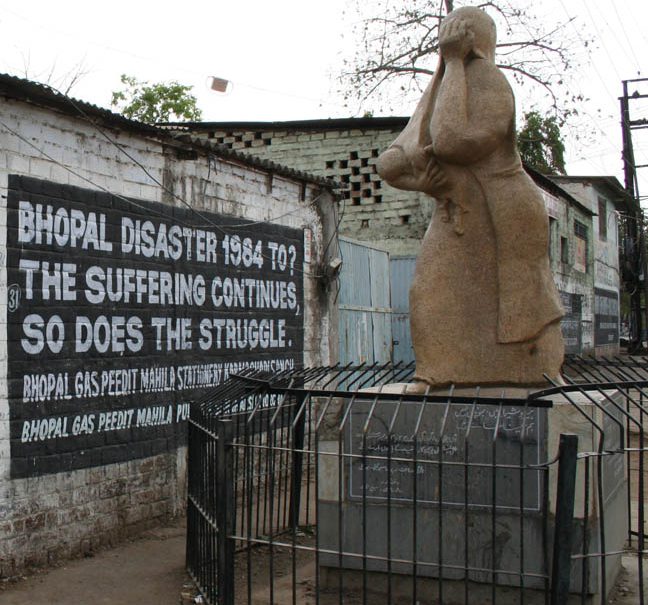How Sandra Mendoza and Veliama Sivaganam came up with Net Economic Outcome

By Luca Frediani uploaded by Simone.lippi, CC BY-SA 2.0
During recent conversation about Brexit, Trump, and widespread public dissatisfaction with the status quo in the US , Europe and elsewhere, I was reminded of a piece I wrote some years ago as part of a short book of essays and observations. It was an attempt to spear some of the nonsense perpetrated both in academia and government about how large-scale economic activity is interpreted and “sold” to the public; and why that interpretation is wholly inadequate. Although framed around two fictional characters and deliberately tongue-in-cheek, the essential details of the piece are as historically and factually accurate as I could make them.
Net Economic Outcome as a concept was introduced by Sandra Mendoza and Veliama Sivaganamin a joint paper presented to the Third Women’s Econo-Solidarity Conference in Porbandar. Despite initial ridicule by academics and dismissal by policy-makers, radicals soon latched onto NETCO as a weapon in their war against capitalism; although it is far from certain that this was the authors’ original intention.
The aim of the Porbandar paper was to elucidate what Mendoza and Sivaganam considered to be a universal confusion between “national or regional economic efficiency”, and the “efficiency of the firm”. Conventional wisdom held (as in many quarters it still does) that the two ideas went hand in hand: in other words, that an efficient private sector offered the best route to the welfare of the people and therefore to the success of the nation or the region in which it operated.
Mendoza and Sivaganam suggested, instead, that private and public efficiency were not only different but, in many cases, mutually exclusive. In a capitalist economy, they claimed, an efficient firm endeavoured to maximise sales, while minimising labour costs and leaving the state with as many associated burdens as possible: pollution, waste, environmental degradation, road maintenance, worker training, social security, unemployment insurance, and so on. But was it economically efficient at national level, they asked, for people to buy superfluities (and create the resultant waste), or for a state to cope with employment instability caused by downsizing or outsourcing, the displacement of small farmers and entrepreneurs by multinationals, the ravages of industrial pollution, and the societal disruptions that accompany extremes of inequality? The prospect of exceptional wealth might well be a spur to enterprise, but wasn’t it too often also a charge on the social fabric? Currency and commodity markets could net handsome rewards for a handful of businesses and individuals, but often by devastating countless numbers of impoverished people in stricken areas of the world.
And what about natural and environmental disasters? Earthquakes, tsunamis, chemical spills, shipwrecked oil tankers could ravish the human environment and cause untold human misery – even though they usually resulted in greater economic activity and an increase in GDP as producers geared up to repair the damage. In economic terms, few things could be better than a catastrophe or a conflict fought in some distant territory where the loss of many lives would be counterbalanced by the enticing prospect of corporate super profits and unprecedented economic growth, first in arms sales, and then in rebuilding towns and industries.
Mendoza’s and Sivaganam’s paper offered some provocative examples of how private sector efficiency could, and often did, mean “screwing the taxpayer”: overcharging on government contracts, bribing officials, blackmailing governments into awarding investment subsidies, circumventing environmental regulations, failing to compensate victims of industrial blight and so on.
They went on to propose a different, more sophisticated analytical vocabulary for assessing economic efficiency and assigning financial responsibility, which would allow the social, environmental and infrastructural impact of corporate activities to be costed and charged.
In a subsequent monograph “Owning up – Investors and the Invested”, the authors argued that so-called private investment is in reality a joint venture in which public goods – roads, railways, airports, an educated workforce etc are joined to private capital. Ownership should, therefore reflect the participation of all investors. Terms such as “Socio-environmental Cost Analysis”, “Input Distribution”, “Capital (Stock) Equivalence”, “Subvention Equity” and “Context Sensitive Accounting”, made their first appearance in this little book.
The personal histories of both Mendoza and Sivaganam bear some relevance to the conclusions they reached about the nature of economic life.
Sandra Mendoza was born in Tegucigalpa, Honduras into a wealthy land-owning family. At seventeen, she began an affair with one of the gardeners at the family hacienda, by whom she became pregnant. When the affair came to light, the gardener was arrested on a rape charge and was never seen again – a not untypical fate in those days for a man who dared to bed above his station.
Mendoza fled to Tuxla Gutierrez in Mexico where she lived for some time in deep poverty. The child – a daughter – died in infancy from a lung infection – Mendoza’s pleas to her family in Honduras for money to buy antibiotics having gone unheeded.
By the age of nineteen, she was in Mexico City working behind the counter in a pharmacy and studying for a degree in Economics at UNAM. After graduating with distinction, she landed a job with Verduras y Aceites de Mexico S.A. – a subsidiary of a large US agroindustrial company. There she played a key role in developing an investment in the far western state of Baja California Sur where the company leased a stretch of semi-desert on the outskirts of the town of Santamaría and collared the local water supply to grow tomatoes for export. The project proved highly profitable, and Mendoza received a substantial salary increase on the strength of her contribution.
On the other side of town, however, where farmers had cultivated the rich soil since the town’s foundation in the late eighteenth century, traditional irrigation channels ran dry and crops failed for lack of water. Proud horticulturists, accustomed to a dignified independence, began sinking into poverty. A few of them found low-paid jobs with the company; many sold their fields as building plots to wealthy newcomers for whom they ended up working as servants, chauffeurs, or even gardeners digging patches of the same soil that had once been theirs. The gap between rich and poor widened, social cohesion weakened; burglary and petty theft – formerly unknown – became commonplace. Beggars appeared on street corners.
This was Mendoza’s first experience of the double-edged sword of western-style industrial investment. Government statisticians registered an increase in local employment and GDP; but who, Mendoza asked herself, were the beneficiaries? And who bore the costs? She wondered if a way could not be found of recognising recipient communities as co-investors and decision-making participants in new projects.
Back in Mexico City, Mendoza met Carlos Restrepo Robles, the exiled Colombian human rights lawyer who was later gunned down at the airport on his return to his homeland. From him, she learned of the notorious El Cerrejón strip coal mine in the north of Colombia owned by a consortium of multinational mining companies. The mine had brought profits to the owners, but despair to local communities whose homes had been razed, fields destroyed, burial grounds desecrated and environment polluted beyond recovery. After Restrepo’s death, she visited the mine and saw for herself the devastation it had wrought on the locality and the indigence into which the former residents of the demolished village of Tabaco had fallen as a result.
Determined to study the issues raised by what she had witnessed in Santamaría and Tabaco, Mendoza resigned from her job and, after turning down offers of scholarships from several western universities, she chose to read for a doctorate at the University of Porbandar. “I didn’t need western professors telling me how people in countries like mine think and feel,” she explained to a colleague who questioned her choice. It was at the university in Porbandar that she met Veliama Sivaganam.
Ms Sivaganam came from a very different background. Born into a poor family in Pudukkottai, a rural district of the Indian state of Tamil Nadu, she and her mother learned to read and write together – thanks to a literacy drive funded by an enlightened local charity. Sivaganam’s father made scant effort to follow suit. Like many men of the district, he had given himself over to the consumption of arrack – a locally-brewed liquor – on which he spent whatever funds he could lay hands on. Officially, private distilleries were forbidden in Tamil Nadu – the local government having awarded licences to a couple of large national distillers that produced IMFL (Indian Made Foreign Liquor). Sales of IMFL through recognised brandy shops provided the government with tax revenues, thus ensuring – as is so often the case – an alliance of interests between government and big business. But that didn’t stop the illegal distilling of cheap arrack for which the demand proved insatiable and the rewards substantial. “In Pudukottai, Tamil Nadu’s least urbanised district,” wrote Palagummi Sainath in 1995 when Sivaganam was still a teenager, “official data show that an arrack distiller is arrested every 45 minutes; and one is convicted every two hours.”
Illegal distillers happily paid their fines – the amounts were derisory compared with their profits from the trade. Then they moved their equipment to another location and carried on as before. Arrack consumption, meanwhile, had become a source of grief and conflict within families. Husbands commonly financed their drinking habit from an already meagre household budget and then under its influence abused wives who had the temerity to complain. Children grew to dread their fathers’ drunken outbursts and the parental disputes they occasioned.
On her twentieth birthday, Sivaganam joined a women’s group formed with the aim of declaring Pudukottai a dry region. They succeeded in having most of the illegal distilleries closed down – but only to find the brandy shops taking their place – backed by the state government and the big liquor companies. IMFL came to dominate the market and since it was more expensive than arrack, drinkers paid for the increase not by reducing their consumption, but by appropriating more of the household income. Children went hungry, but like whales feeding on plankton, big business and government got a little fatter.
The protest movement intensified. Campaigners petitioned the authorities, organised protest marches, bombarded the local media with demands to be heard and read. Scandals came to light: a senior government official was found to be in the pay of a liquor multinational; another was discovered running an arrack distillery of his own. Some of the women suffered beatings and ostracism in their village. All the leaders received threats. The campaign continues to this day – partially successful but never completely so – as is invariably the case with human effort.
Sivaganam received repeated beatings at her father’s hands and narrowly escaped death when he returned home drunk one night, doused her with kerosene and tried to set her on fire. The poor quality of the fuel saved her: it had been adulterated with water. After this, she fled to Madras where she found employment – coincidentally also in a pharmacy – and took night classes in economics and political science at the university.
Two years later, she published a paper – “Profit and Losses” the first of many on the social costs of large-scale corporate enterprise. In it she argued that Adam Smith’s ideal of business serving the people (even if unwittingly) had been reversed. The effect of western capitalism had not been to make the market serve the people, but to bend the people to the needs of the market. The paper was not especially original, but it contained useful references to Sivaganam’s experience in Pudukottai where the campaign against illegal arrack distilling had handed much of the market to external suppliers, allowing them to suck funds out of the area.
For her degree dissertation, she conducted a study of two large-scale industrial investments: the infamous Union Carbide plant in Bhopal where, on 2nd and 3rd of December 1984, a cloud of toxic vinyl chloride gas leaked into the air, killing 3,000 people in the first 24 hours and tens of thousands of others in the weeks, months and years that followed; and the Sardar Sarovar dam on the Narmada River in Madya Pradesh where countless villages have been submerged, and upwards of half a million people uprooted and left with little provision for their livelihoods. In the course of this study, she began to form her theory of “default economics”, the term she coined for the failure of corporations and governments to account for the full social costs of their operations. “Only those expenses from which they can’t hide are counted,” she concluded in an oft-quoted peroration. “And these are considered solely in relation to the business or the project itself. Responsibility for the human costs of Bhopal or Sardar Sarovar accrue to some other entity: to the state perhaps or charity, to history or to God.”
(please note that whilst many of the events and contexts are real, this story is fictional)






